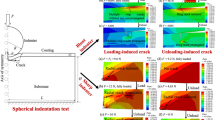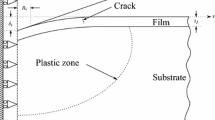Abstract
The paper proposes a new method for adhesion strength assessment of polymer coatings which is based on Rockwell indentation with experimental data processing via finite element simulation in terms of fracture mechanics (cohesive zone model, CZM). With the example of a titanium-alkoxide epoxy composition deposited on low-carbon steel, it is shown that when the Rockwell indenter penetrates perpendicular to the coating surface, circular buckling delamination around its indent occurs due to adhesive bond rupture by radial shear with extrusion of the coating material from beneath the indenter. The parameter controlled in the simulation is the width of coating delamination zones formed in indentation experiments at a constant indentation depth. The conditions of adhesive contact are specified using the CZM bilinear law, which describes the relation between the tangential adhesive stress and the adhesive bond elongation under shear in the contact plane of interacting surfaces. The criterion of quantitative adhesion strength assessment is the ultimate specific surface energy of adhesive failure. The simulation gives an optimum value of the ultimate specific surface energy of adhesive failure of the coating at CZM parameters that provide the best convergence of the numerical and experimental data.








Similar content being viewed by others
Notes
The equipment was provided by the Plastometria Collective Center of IES UrB RAS.
REFERENCES
Gdoutos, E.E., Fracture Mechanics, Solid Mechanics and Its Applications, Switzerland, AG: Springer Nature, 2020.
Lunev, V.L. and Nemashkalo, O.V., Adhesion Characteristics of Coatings and Methods of Their Measurements, Fiz. Inzh. Poverkhn., 2010, vol. 8, no. 1, pp. 64–71.
Schwarzer, N. and Richte, F., Adhesion and Elastic Contact Stresses of Coating/Substrate Systems under Normal and Tangential Loads, Surf. Coat. Technol., 1995, vol. 74–75, no. 1, pp. 97–103.
Smirnov, S.V., Myasnikova, M.V., and Igumnov, A.S., Determination of the Local Shear Strength of a Layered Metal Composite Material with a Ductile Interlayer after Thermocycling, Diagnost. Resource Mech. Mater. Struct., 2016, vol. 4, pp. 46–56.
Kleinbichler, A., Pfeifenberger, M.J., Zechner, J., Moody, N.R., Bahr, D.F., and Cordill, M.J., New Insights into Nanoindentation-Based Adhesion Testing, J. Mineral. Met. Mater. Soc. (TMS), 2017, vol. 69, no. 11, pp. 2237–2245.
Volinsky, A.A., Moody, N.R., and Gerberich, W.W., Interfacial Toughness Measurements for Thin Films on Substrates, Acta Mater., 2002, vol. 50, pp. 441–466.
Golovin, Yu.I., Nanoindentation and Mechanical Properties of Solids in Submicrovolumes, Thin Near-Surface Layers, and Films: A Review, Phys. Solid State, 2008, vol. 50, pp. 2205–2236. https://doi.org/10.1134/S1063783408120019
Michael, M., Holger, V., and Stefan, H., Predictive Modeling of Damage and Failure in Adhesively Bonded Metallic Joints Using Cohesive Interface Elements, Int. J. Adhes. Adhes., 2014, vol. 49, pp. 7–17.
Khan, M.A., Silberschmidt, V.V., and El-Rimawi, J., Controlled Failure Warning and Mitigation of Prematurely Failing Beam through Adhesive, Compos. Struct., 2017, vol. 161, pp. 119–131.
Piculin, S., Nicklisch, F., and Brank, B., Numerical and Experimental Tests on Adhesive Bond Behaviour in Timber-Glass Walls, Int. J. Adhes. Adhes., 2016, vol. 70, pp. 204–217.
Goldstein, R.W. and Perelmuter, M.N., Modeling of Crack Resistance of Composite Materials, Vych. Mekh. Sploshn. Sred, 2009, vol. 2, pp. 22–39.
Panigrahi, S.K. and Pradhan, B., Onset and Growth of Adhesion Failure and Delamination Induced Damages in Double Lap Joint of Laminated FRP Composites, Compos. Struct., 2008, vol. 85, pp. 326–336.
Chernyakin, S.A. and Skvortsov, Yu.V., Analysis of Delamination Propagation in Composite Structures, Vestnik SibGAU, 2014, vol. 56, no. 4, pp. 249–255.
Wang, X., Wang, C., and Atkinson, A., Interface Fracture Toughness in Thermal Barrier Coatings by Cross-Sectional Indentation, Acta Mater., 2012, vol. 60, pp. 6152–6163.
Chen, J. and Bull, S., Approaches to Investigate Delamination and Interfacial Toughness in Coated Systems: An Overview, IOP J. Phys. D. Appl. Phys., 2011, vol. 44, no. 3, p. 34001. http://dx.doi.org/10.1088/0022-3727/44/3/034001
Pestov, A.V., Kuznetsov, V.A., Mekhaev, A.V., Gorbunova, T.I., Saloutin, V.I., Smirnov, S.V., Vichuzhanin, D.I., and Matafonov, P.P., Designing New Adhesive Materials Based on Epoxy Oligomers Filled with Organic Compounds, Polymer Sci. D, 2015, vol. 8, no. 2, pp. 149–152.
Lawn, B.R., Evans, A.G., and Marshall, D.B., Elastic/Plastic Indentation Damage in Ceramics: The Median/Radial Crack System, J. Am. Ceram. Soc., 1980, vol. 63, nos. 9–10, pp. 574–581. https://doi.org/10.1111/J.1151-2916.1980.TB10768.X
Marshall, D.B. and Evans, A.G., Measurement of Adherence of Residually Stressed Thin Films by Indentation. I. Mechanics of Interface Delamination, J. Appl. Phys., 1984, vol. 56, pp. 2632–2638.
Evans, A.G. and Hutchinson, J.W., On the Mechanics of Delamination and Spalling in Compressed Films, Int. J. Solids Struct., 1984, vol. 20, pp. 455–466.
Hutchinson, J.W. and Suo, Z., Mixed Mode Cracking in Layered Materials, Adv. Appl. Mech., 1991, vol. 29, pp. 63–191.
Boer, M.P. and Gerberich, W.W., Microwedge Indentation of the Thin Film Fine Line. I. Mechanics, Acta Mater., 1996, vol. 44, no. 8, pp. 3169–3175. https://doi.org/10.1016/1359-6454(95)00426-2
Rosenfeld, L.G., Ritter, J.E., Lardner, T.J., and Lin, M.R., Use of the Microindentation Technique for Determining Interfacial Fracture Energy, J. Appl. Phys., 1990, vol. 67, p. 329. https://doi.org/10.1063/1.345363
Oliver, W.C. and Pharr, G.M., An Improved Technique for Determining Hardness and Elastic Modulus Using Load and Displacement Sensing Indentation Experiments, J. Mater. Res., 1992, vol. 7, no. 6, pp. 1554–1583.
Jia, Y., Peng, K., Gong, X., and Zhang, Z., Creep and Recovery of Polypropylene/Carbon Nanotube Composites, Int. J. Plasticity, 2011, no. 27, pp. 1239–1251.
Kochetov, V.T., Kochetov, M.V., and Pavlenko, A.D., Strength of Materials: Handbook for Students, St. Petersburg: BKhV–St. Petersburg, 2004.
Kiffer, R. and Berezowsky, F., Hard Alloys, Moscow: Metallurgia, 1971.
Alfano, G. and Crisfield, M.A., Finite Element Interface Models for the Delamination Analysis of Laminated Composites: Mechanical and Computational Issues, Int. J. Numer. Meth. Eng., 2001, vol. 50, pp. 1701–1736.
Xu, X. and Needleman, A., Numerical Simulation of Fast Crack Growth in Brittle Solid, J. Mech. Phys. Solids, 1994, vol. 42, no. 9, pp. 1397–1434.
Hooke, R. and Jeeves, T.A., Direct Search. Solution of Numerical and Statistical Problems, J. ACM, 1961, vol. 8, pp. 212–229. https://doi.org/10.1145/321062.321069
ACKNOWLEDGMENTS
The authors are thankful to A.S. Igumnov, Head of the System Support Department of the Supercomputer Center of IMM UrB RAS, for assisting the numerical computations and to V.A. Osipova from the Laboratory of Organic Materials, IOS UrB RAS, for preparing the coated specimens.
Funding
The work was performed under research project No. AAAA-A18-118020790145-0.
Author information
Authors and Affiliations
Corresponding author
Rights and permissions
About this article
Cite this article
Smirnov, S.V., Myasnikova, M.V., Pestov, A.V. et al. A New Method for Adhesion Strength Assessment of Indented Polymer Coatings. Phys Mesomech 26, 514–522 (2023). https://doi.org/10.1134/S1029959923050041
Received:
Revised:
Accepted:
Published:
Issue Date:
DOI: https://doi.org/10.1134/S1029959923050041




